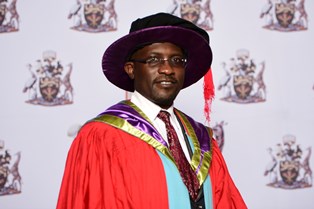
Samuel Aringo Were, received MSc. in Crop Protection from the University of Nairobi in 2012. In the Thesis titled, “Distribution of Potato Tuber moth (Ptheromeae opercullela) in Kenya and Management strategies in Kenya” I sought to determine the distribution of potato tuber moth in potato growing areas of Kenya. I also determined the varietal resistance to potato tuber moth in locally grown potatoes. My research interests include sustainable management of plant pest and diseases; plant microbe interaction and the pathways of these interactions leading to enhanced plant resistance to biotic stresses. In line with these, i pursued a doctorate degree in Crop Protection. My thesis titled “Characterisation of Bean root rot fungi from soils in Western Kenya and their management with biochar and vermicompost” sought to identify the different bean root rot pathogens in Western Kenya using different techniques. I also sought determine the effect of the soil amendments in management of root rot as well as elucidate the mechanism by which these amendments enabled the suppression of disease and increase bean productivity.
Abstract
The root rot disease complex has continued to be a major constraint in the production of common beans (Phaseolus vulgaris) resulting in losses of up to 70% in Kenya. The aim of this study was to establish (i) the occurrence and quantification of root rot fungal pathogens of common bean in Western Kenya and (ii) the effect of farming practices on the populations of the pathogens. A survey was conducted in Western Kenya’s LM1 LM2 UN1 and UM3 AEZ’s to obtain data on different farming practices and soil characteristics. Pathogens were isolated and identified using morphological and molecular techniques. Soil pH ranged from 4.59 to 6.01, Percent carbon and nitrogen ranged from 9.8 g/Kg0 to 19 g/Kg and 0.8 g/Kg to 1.5 g/Kg. All farms were infected with root rot fungi, including Fusarium solani, Pythium ultimum, Rhizoctonia solani and Macrophomina phaseolina. Fusarium spp. was the most abundant with the highest populations of 62 X 103 cfu/g soil recorded in lower midland zone 2. The isolation frequency of Fusarium spp., Pythium spp. and Rhizoctonia spp. was high in upper midland zone 1. Quantification of genomic DNA from soil by qPCR was highest for Rhizoctonia solani (2.23 X 100 pg µL-1). Sand had a positive correlation with Pythium ultimum DNA and Rhizoctonia solani DNA while clay had a negative correlation with Fusarium spp. and Rhizoctonia solani DNA. In conclusion, soil properties, management practices and elevation affected root rot pathogen populations and should be considered when developing management strategies.
Research Supervisors
Research Supervisors
Prof. Rama D. Narla,
Prof. Eunice W. Mutitu
Prof. James W. Muthomi
